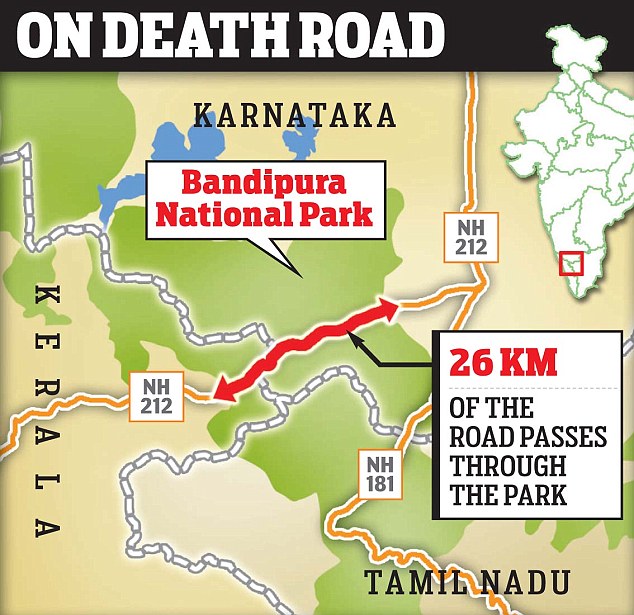Why in news?
The Centre has asked Karnataka the consent to allow night traffic on the highway passing through Bandipur Tiger Reserve.
What and why is the current restriction?
- The National Highway (NH) 212 cuts through the Bandipur Tiger Reserve.
- Speeding vehicles on the highway were taking a toll on the reserve’s animals.
- This included tigers, elephants and several other endangered species.
- Karnataka High Court thus, in 2010, banned traffic between 9 pm and 6 am through the highway.
- Road kills have dropped by nearly six times after it was imposed.
- Neighbouring Tamil Nadu has imposed a similar measure in the Mudumalai Wildlife Sanctuary.

What is the contention?
- The Kerala government has contested the restriction, in the Supreme Court.
- It said it was an inconvenience to those travelling from Wayanad (Kerala) to Karnataka and also hampering the state’s economic development.
- However, the Karnataka High Court order does offer a middle path.
- It suggests an alternate road to the standards of NH 212 to take care of Kerala’s concerns.
- The National Tiger Conservation Authority has also spoken in favour of such a solution.
- This is an ongoing case in the Supreme Court.
What is the Centre's proposal?
- Before the arrival of SC judgement, the Centre now tries to relax this ban.
- The Centre has asked the Karnataka government to give consent to open the road 24×7 with certain mitigation measures.
- The proposal included elevating the road over four 1-km stretches to provide wildlife passageways below.
- It also proposes to fence the entire highway passing through the reserve with 8-foot-high steel wire barriers.
- Rationale - The argument for not going for a new alternative road is that it would be 30 km longer and pass through hilly terrain.
- It thus increases travel time, fuel consumption, and pollution.
- Also, it is argued that as traffic endangers wildlife even during the day, fencing and passageways are a better idea.
What are the larger concerns?
- Plan - Underpasses are unlikely to suffice in dense wildlife-rich forests where too many animals compete for space.
- For territorial animals, just four openings in a 24-km stretch may not suffice.
- They may have to use a passageway in their neighbour’s territory to move between two halves of its territory (split by the highway).
- This may endanger them through the resultant habitat and prey loss.
- Threat - Roads, railway lines and irrigation canals become barriers that hinder wildlife movement.
- This is especially worse at night when bright headlights blind even swift species like cats.
- This, in turn, contributes to habitat loss, fragmenting wildlife populations and restricting their gene flow.
- Global examples - Roads have destroyed tropical rainforests in South America, Asia and Africa too.
- Though under severe pressure, the Amazon rainforests still hold over 1 million sq km of no-go zones.
- In North America and Europe, where road network is extensive and wildlife density lower, wildlife passageways are more common.
- Such features are seen in Malaysia and Kenya as well, and in South Africa, night traffic is prohibited.
What is the policy in this regard?
- National Board for Wildlife (NBWL) is the apex advisory body to the central government on all wildlife-related matters.
- In 2013, the NBWL objected to any new roads through protected forests.
- It was however open to the widening of existing roads only if alternative alignments were not available.
- It nevertheless mandated adequate mitigation measures irrespective of the cost.
- The government accepted this as the policy in 2014.
- Recently, the NBWL made it mandatory for every road/rail project proposal to include a wildlife passage plan.
- This has to be as per guidelines framed by Wildlife Institute of India.
- However, passageways have their own limitations in dense forests.
What lies ahead?
- Based on Karnataka’s response to the Centre's request, an earlier appointed committee will finalise and submit its report before the Court.
- It is to be assessed if the 3okm alternative road is an unaffordable economic burden or a minor concession necessary.
Source: Indian Express
